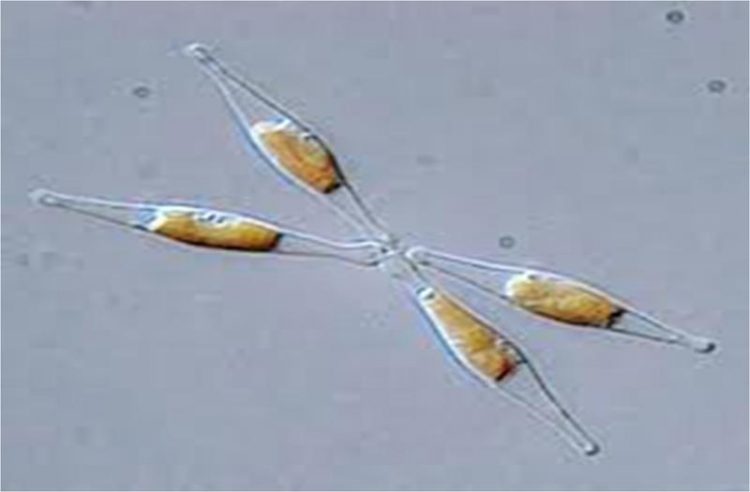In between red and blue light: Researchers discover new functionality of molecular light switches

Microscopical picture of a diatom. Photo: Leipzig University, Christian Wilhelm
Researchers at Leipzig University and the Helmholtz Centre for Environmental Research have now discovered that blue and red light sensing photoreceptors control the carbon flow in these algae. These results have been recently published by the scientists in the well-known online trade journal, PLOS ONE.
“Diatoms display a special way of reacting to light and adapting their metabolism to the changing light conditions in the water”, says Prof. Dr. Christian Wilhelm, Head of the Plant Physiology Department at Leipzig University.
“For the first time, we have been able to show that the light receptors, which measure the intensity of the blue or red light, not only change the genetic transcription, but also directly control the activity of enzymes in the metabolism.”
A rapid light change from blue light to red light and vice versa does not influence the photosynthesis output, but the metabolism is drastically reversed within 15 minutes. “This way, cells that have grown in red light, which continue to be cultivated in a blue light environment can still perform photosynthesis, but can no longer grow.”
These “light switches” can be used to control the carbon flow in cells. The evidence for this was provided using the MetaPro metabolomic platform established at the Helmholtz Centre for Environmental Research. “This opens up new ways for the biotechnological control of cells”, explains Christian Wilhelm.
“This work is further evidence of the added-value of intensive cooperations between non-university and university institutions, particularly with the Faculty of Biosciences, Pharmacy and Psychology”, Prof. Martin von Bergen, Spokesman of the Department of Metabolomics at the UFZ and one of the co-authors, is pleased to say.
The Leipzig-based algae experts in plant physiology at Leipzig University already drew attention to itself two years ago with another publication: Together with scientists from Karlsruhe and Bremen, they provided evidence that sunlight can be converted into pure natural gas in a highly efficient manner with the aid of microorganisms. In doing so, the metabolism of green algae is reversed.
The publication about the diatoms:
The Acclimation of Phaeodactylum tricornutum to Blue and Red Light Does Not Influence the Photosynthetic Light Reaction but Strongly Disturbs the Carbon Allocation Pattern
DOI: 10.1371/journal.pone.0099727
The publication about the green algae:
Methane production from glycolate excreting algae as a new concept in the production of biofuels
DOI: 10.1016/j.biortech.2012.06.120
Contacts:
Prof. Dr. Christian Wilhelm
Institut for Biology, Plant Physiology
Tel: 0341-97-36874
E-mail: cwilhelm@rz.uni-leipzig.de
Internet: http://www.uni-leipzig.de/~pflaphys/
Prof. Dr. Martin von Bergen, Dr. Sven Baumann
Department of Metabolomics at the Helmholtz Centre for Environmental Research
Tel.: 0341-235-1211, -1099
E-mail: martin.vonbergen@ufz.de
E-mail: sven.baumann@ufz.de
Internet: http://www.ufz.de/index.php?de=17634
Internet: http://www.ufz.de/index.php?de=18274
http://www.plosone.org/article/info%3Adoi%2F10.1371%2Fjournal.pone.0099727 The publication about the diatoms
http://www.sciencedirect.com/science/article/pii/S0960852412010395 The publication about the green algae
Media Contact
All latest news from the category: Life Sciences and Chemistry
Articles and reports from the Life Sciences and chemistry area deal with applied and basic research into modern biology, chemistry and human medicine.
Valuable information can be found on a range of life sciences fields including bacteriology, biochemistry, bionics, bioinformatics, biophysics, biotechnology, genetics, geobotany, human biology, marine biology, microbiology, molecular biology, cellular biology, zoology, bioinorganic chemistry, microchemistry and environmental chemistry.
Newest articles

Properties of new materials for microchips
… can now be measured well. Reseachers of Delft University of Technology demonstrated measuring performance properties of ultrathin silicon membranes. Making ever smaller and more powerful chips requires new ultrathin…

Floating solar’s potential
… to support sustainable development by addressing climate, water, and energy goals holistically. A new study published this week in Nature Energy raises the potential for floating solar photovoltaics (FPV)…

Skyrmions move at record speeds
… a step towards the computing of the future. An international research team led by scientists from the CNRS1 has discovered that the magnetic nanobubbles2 known as skyrmions can be…





















